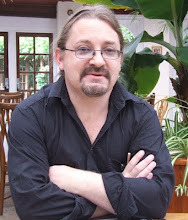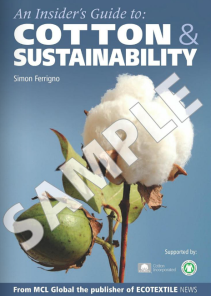 This interview was originally published by Netzwerk Fair Mode in June 2012. It is republished with permission.
This interview was originally published by Netzwerk Fair Mode in June 2012. It is republished with permission.
Interview by: Jana Kern, founder of Kern Kommunikation.
“The situation is not necessarily negative.”
Uncertainty is widespread in the cotton market: Textile Exchange published organic cotton production figures. The current Farm & Fiber Report shows a drastic decrease. Jana Kern talked to consultant and cotton expert, Simon Ferrigno, about the current developments of the organic cotton sector and about his predictions for the future of the eco fashion market.
Jana Kern: According to the report the world production of organic cotton fell by 35 %. The greatest decline has occurred in India where almost 70% of organic cotton grows. How could this happen?
Simon Ferrigno: The decline in India has been significant but this may reflect a readjustment following speculation, over-reporting of figures and some spurious numbers based on possible fraud or poor practice. In other words, this may be a welcome development as these rumours have been damaging the sector for some time. The impact of the introduction of the Tracenet in India by the APEDA agency is beginning to have an impact, fulfilling its goal of stopping export of ‘spurious’ product. There is also decline in demand and reduced production because producers still do not clear and timely commitments from buyers. Other countries are maintaining their production so it is clear that much of the problem is indeed focussed more on India, although the claims for increase in the report do not always reflect back that in some cases the increases are back to the levels of a few years ago, as there has been volatility in the market for some time and the problems in India of artificially low organic prices and over-reported production had badly hurt some producer groups in places such as West Africa and Turkey.
JK: What does that development mean to the eco fashion sector?
SF: The situation is not necessarily negative – it represents an opportunity for organic cotton to rebuild itself on more solid foundations based on the serious and committed long established producer groups in both India and around the world; the industry needs responsible trading and sourcing guidelines and behaviours that are monitored and if necessary enforced, something I have been calling for for several years.
This includes addressing prices and the real costs of producing sustainably, which cannot be done at the same price as conventional cotton. Indeed, McKinsey, the consultancy, have put a figure on the negative external costs of cotton which if reflected would make organic cotton not more expensive but more affordable if these costs were included in cotton prices. But the organic cotton sector needs to face up to its responsibilities as it is being challenged in the market by Fairtrade and even more so by Better Cotton and Cotton Made in Africa, all of which address price, labour and trading issues.
JK: Is the market destabilized?
SF: The market has been unstable for several of the past 7 or 8 years as demand is often unclear and short term with last minute orders, little structure, a lot of price volatility and some price speculation. The sector has grown too fast with too little thought to structure or planning or long term approaches to price, contracts and planning of production to farmers. It takes 2-3 years for farmers to convert and 7-8 years for small farmers to build the right production and support system, yet most brands do not communicate orders in advance and few set up long term supply arrangements with producer groups. The organic cotton sector has been treated more and more like the conventional supply system despite its very different needs.
JK: What are the effects on the supply situation?
SF: The supply situation will be tight in the short term but in the market, at least here in the UK, organic continues to grow among small and medium sized brands while there are declines for some larger brands, partly driven by a move towards Better Cotton, so things will not be too bad.
JK: How do cotton organizations react?
SF: There is concern among organisations that organic cotton has had too high a profile in recent years but even more that organic cotton has been campaigning negatively against other cottons and not working constructively enough. Some of them are thus taking a certain delight in these figures but on the other hand, the door is open for cotton as an industry to work collaboratively to promote sustainability and continue progress. For many traders, organic cotton remains an option as long as there is demand but for all working at the fibre level there is a need for industry promoters of organic to work to improve the trading environment, which needs more stable conditions and an ability for producers, ginners and traders to be able to earn a living and plan more for the long term.
JK: How do the big companies like Marks & Spencer, Walmart, C&A, H&M operate?
SF: For cotton companies with a relatively high use of cotton in their products, organic cotton remains a strategic choice and commitment. Nowadays, they are adding other options such as Fairtrade, Better Cotton and CmiA to try and reach 50-100% levels of sustainable cotton use. However, some retailers are switching more to Better Cotton and dropping organic, and this usually reflects brands with lower retail prices and higher use of synthetic fibres.
JK: How is the price development for organic cotton right now and how might it be in future?
SF: Prices for organic cotton remain quite volatile reflecting both the movements in conventional cotton but also the fact that many producers do not have long term contracts and so charge what they can. I have seen some lower prices for those producers in long term business relationships, who prefer the stability of this rather than short term gain, as they know they will be protected should prices fall but this is not the norm. Generally, organic cotton currently sells for the same or 10-20% more than conventional when sold as lint, although there are a few cases when it sells for less in India than some premium cotton.
JK: Will alternative sustainable cotton or sustainable fibres in general be more important in future?
SF: Definitely, sustainable cotton sourcing is part of the strategy of many large international brands and it is hard to see this trend reversing even if growth may fluctuate slightly according to global economic conditions.
JK: How are the future scopes for the eco textile market in your opinion?
SF: The cotton sector at fibre level has seen dramatic reductions in the use of pesticides and insecticides, as well as the growth of sustainable cotton initiatives, beginning with organic but now including Fairtrade, Cotton Made in Africa, Better Cotton Initiative, Sustainable Cotton Project as well as brand specific initiatives by people like C&A. The sustainability question is important to sector survival: water, land and energy are now scarce resources, so making as much or more from less and ensuring that the productive base is secured for the future are economic imperatives.
—-
 Simon Ferrigno is the owner oft he consultancy Sustainable & Organic Farm Systems in Derbyshire/UK. He is the author of ‘An Insider’s Guide to Cotton and Sustainability‘, which he co-published with John Mowbray from British publishers MCL Global in March. The publishing of the guide was supported by the Aid by Trade Foundation, GOTS and Cotton Inc. In his guide Ferrigno looks at cotton and sustainability including all the certified options such as organic and Better Cotton.
Simon Ferrigno is the owner oft he consultancy Sustainable & Organic Farm Systems in Derbyshire/UK. He is the author of ‘An Insider’s Guide to Cotton and Sustainability‘, which he co-published with John Mowbray from British publishers MCL Global in March. The publishing of the guide was supported by the Aid by Trade Foundation, GOTS and Cotton Inc. In his guide Ferrigno looks at cotton and sustainability including all the certified options such as organic and Better Cotton.

